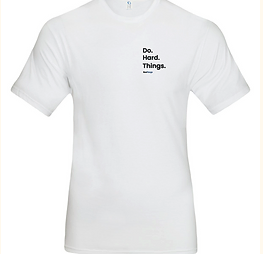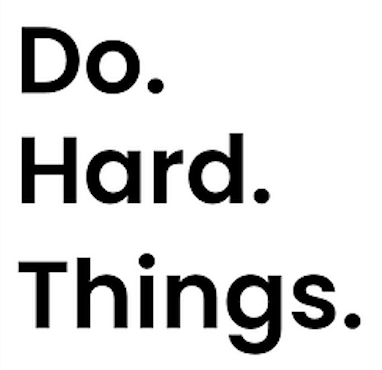Do. Hard. Things.
Table of contents:
- The “Do. Hard. Things.” Mantra
- Limbic Friction: Embracing Uncomfortability
- Cold Plunge: A Gateway to Grit
- A Deep Dive into the Benefits of Cold Plunge
- Conclusion
The phrase “Do. Hard. Things.” has gained much traction in recent years, becoming a mantra for those seeking to improve and better themselves. But what does it truly mean? How does it link to an intriguing concept originally coined by “Andrew Huberman” called “limbic friction“? And, what does the age-old practice of cold plunge have to do with all these? Let’s dive in.

Do. Hard. Things. T-shirt
The “Do. Hard. Things.” Mantra
At its heart, “Do. Hard. Things.” is a call to action. It’s a mindset that encourages pushing oneself beyond the realm of comfort and ease, stepping into the territory of challenges, adversity, and growth. It’s a call to intentionally seek out and embrace difficult tasks, to stretch ourselves, and to do the work that may be intimidating or uncomfortable, yet ultimately rewarding.
The truth is, our modern lifestyle often lets us avoid hardship. We live in a world of convenience where we can obtain almost anything we want with just a click of a button. However, this convenience culture may also rob us of the opportunities to grow and strengthen ourselves. It’s through doing hard things, overcoming adversity, and grappling with challenges that we build resilience, mental fortitude, and a deep sense of accomplishment. It’s how we reveal to ourselves what we’re truly capable of.
Limbic Friction: Embracing Uncomfortability
This is where “limbic friction” comes into play. The limbic system, a part of the brain that deals with emotions, motivation, and fear responses, is deeply wired to seek comfort and safety. When we step out of our comfort zone, we often experience a psychological resistance—this is what we call limbic friction.
Limbic friction is that discomfort or fear you feel when you’re about to do something new, challenging, or uncertain. It’s your brain’s way of saying, “This is unfamiliar and potentially dangerous. Let’s stay in our safe, known territory instead.”
However, it’s crucial to understand that not all discomfort is a red flag. Often, it’s a sign that we’re pushing against our current boundaries, growing, and developing. By recognizing and embracing limbic friction, we can use it as a compass pointing towards personal growth.
Cold Plunge: A Gateway to Grit
One tangible method to apply the “Do. Hard. Things.” philosophy and learn to tolerate limbic friction is through cold plunging—immersing yourself in extremely cold water for a brief period. This practice has been around for centuries, and while it may sound daunting, it offers an array of benefits, including improved circulation, enhanced immunity, and reduced muscle inflammation.
But perhaps more importantly, it’s a powerful way to boost your grit and stress tolerance. Stepping into cold water goes against our natural instincts and creates a substantial amount of limbic friction. It’s uncomfortable and challenging, but with regular practice, it teaches us to endure and overcome discomfort. Each time you step into that cold water, you’re not just boosting your physical health; you’re also reinforcing the habit of doing hard things and proving to yourself that you can withstand challenging situations.
A Deep Dive into the Benefits of Cold Plunge
The practice of cold plunge, as discussed, can push us past our comfort zone, confronting and overcoming limbic friction. But, this intentional challenge is not without its rewards. As outlined in a comprehensive blog post on MiamiPlunge, “Proven Cold Plunge Benefits”, the benefits are wide-ranging, from improving both mental and physical health to reducing inflammation and boosting athletic performance.
The post illuminates the fact that temperature is a potent stimulus, one that triggers a powerful dopamine release that can last for hours. This sensation is likened to the stress experienced in our daily lives, teaching us to maintain calmness in stressful environments – another instance of handling limbic friction.
As the cold engulfs us, our brain cognitive function can decrease by 30% to 80%. However, we can use this state to either engage in cognitive challenges or to fully relax, training ourselves to keep clarity of mind amidst stress. The sensation of a thermal layer forming around your body as you sit still, or the surge of cold as you move and break that layer, further emphasizes the sensory experiences linked with overcoming discomfort.
This practice enhances mental toughness, resilience, and grit, fostering a greater tolerance for challenges. The recommended goal of 11 minutes per week is suggested as optimal, but can be adjusted based on personal preference and health guidance.
In all its intensity and rigor, the cold plunge provides a tangible and immersive way to live out the “Do. Hard. Things.” mantra, reinforcing our capacity to tolerate and conquer discomfort, thus giving us a more intimate understanding of our own strengths and capabilities.
Concluding Thoughts: Do Hard Things, Overcome Limbic Friction
In conclusion, the “Do. Hard. Things.” mantra and the concept of limbic friction are tightly interwoven, serving as constant reminders of our ability to transcend comfort for the sake of growth. They push us to confront our fears, take on challenges, and forge resilience in the process.
Initiatives like cold plunging might seem extreme, but they are practical ways to embody this mindset and, quite literally, immerse ourselves in the experience of overcoming discomfort. It’s
